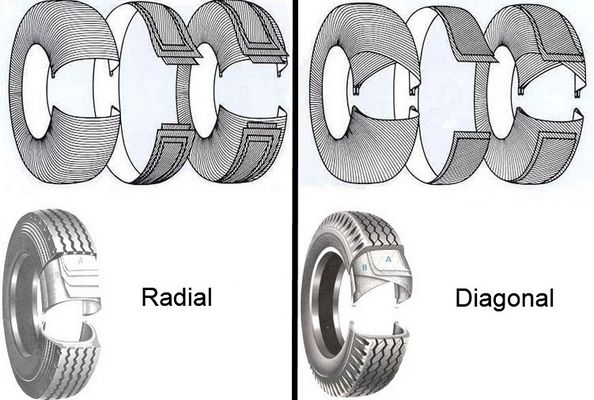Number of plies and load index
What is a tyre ply?
The structure of the casing is key in order to increase the robustness of a tyre. Plies are layers of fabric ( kevlar, nylon, polyesther) that cover the whole of the casing, from bead to bead. They are placed in sensitive areas of the tyre
- In direct contact with the chafer to limit scrubbing against the wheel.
- Above the layer of synthetic rubber that serves the purpose of the air valve for Tubeless tyres
Some tyres have differences in the way their layers of plies overlap. They break down into two main categories: diagonal tyres in which plies cross at 55° angles whereas radial tyres include layers of plies overlapping perpendicularly to the axis of rotation.

Today, most diagonal tyres have been replaced with radial tyres except for specific uses
Thanks to technological innovation and the invention of synthetic fabric, the materials used for plies have evolved.
The load index/ ply number indicated on the sidewall is instrumental in determining the maximum load the tyre car bear according to manufacturers.
The load index for passenger cars are indicated by a letter whereas utility tyres use a letter system ( with resistance growing larger as you get nearer the end of the alphabet)
Before ply ratings became the norm, the actual number of plies was indicated to illustrate tyre resistance. The more plies, the better the resistance.
Today, the ply rating doesn't faithfully indicate the number of plies. Instead, it indicates the equivalent resistance to plies of bygone days.
Most modern passenger car tyres carry no more than one or two physical plies while utility tyres that indicate 12 or 14 plies in reality carry few more than two or three fabric plies or a steel belt..
| European system for ply index an maximum pressure/ Passenger |
|---|
| Load index | Denomination | Maximum pressure |
|---|
| Standard load | SL | 2.45 bars |
| Reinforced load | XL | 2.8 bars |
| European system for ply index an maximum pressure/ Light trucks |
|---|
| Load index | Ply rating | Maximum pressure |
|---|
| B | 4 | 2.45 bar |
| C | 6 | 3.35 bar |
| D | 8 | 4.35 bar |
| E | 10 | 5.30 bar |
| F | 12 | 6.30 bar |


